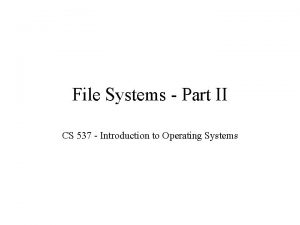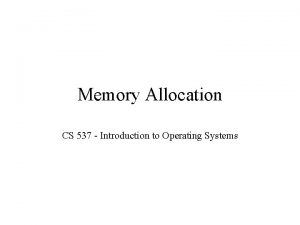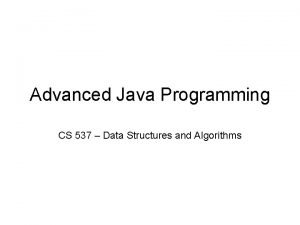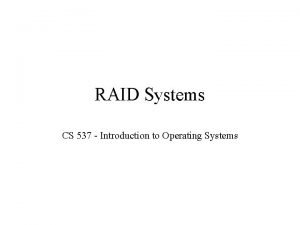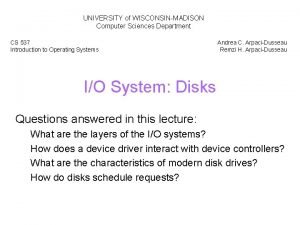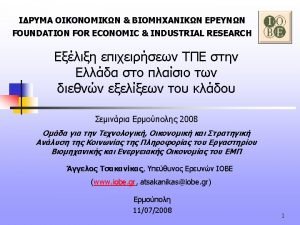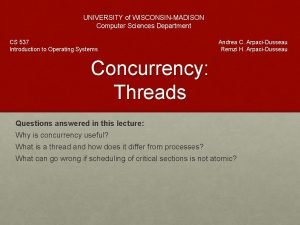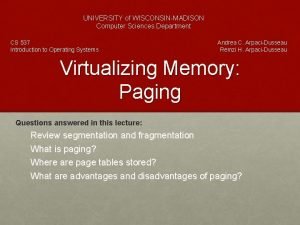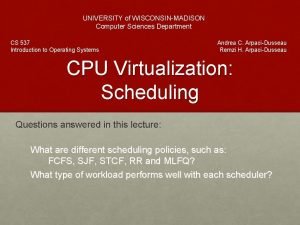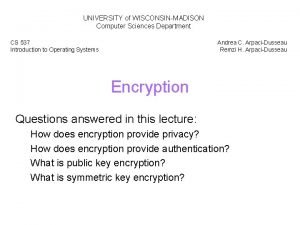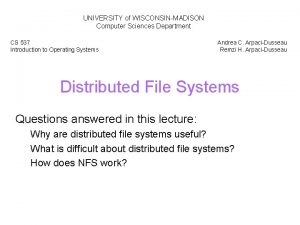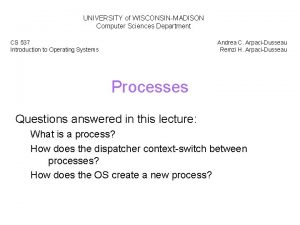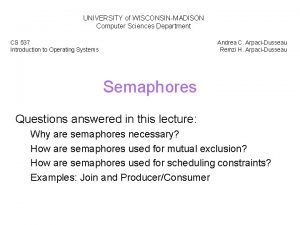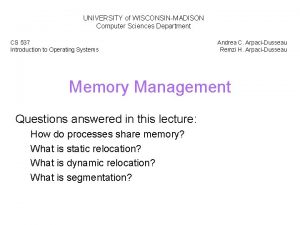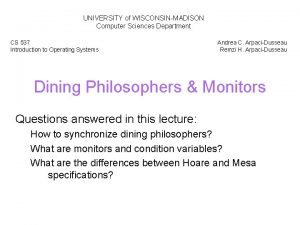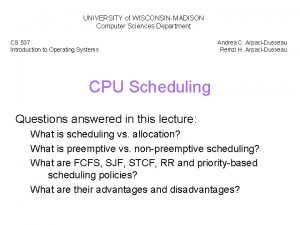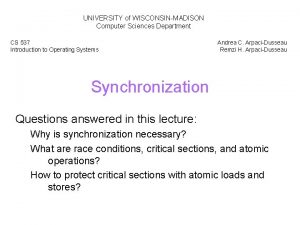UNIVERSITY of WISCONSINMADISON Computer Sciences Department CS 537














- Slides: 14

UNIVERSITY of WISCONSIN-MADISON Computer Sciences Department CS 537 Introduction to Operating Systems Andrea C. Arpaci-Dusseau Remzi H. Arpaci-Dusseau Virtual Memory: Working Sets Questions answered in this lecture: How to allocate memory across competing processes? What is thrashing? What is a working set? How to ensure working set of all processes fit?

Allocating Memory across Processes Scenario: • Several physical pages allocated to processes A, B, and C. Process B page faults. • Which page should be replaced? • Three options. . . Per-process replacement • Each process has separate pool of pages – Fixed number of pages (e. g. , Digital VMS) – Fixed fraction of physical memory (1/P) – Proportional to size of allocated address space • Page fault in one process only replaces pages of that process – Perform replacement (e. g. , LRU) over only those pages • Advantage: No interference across processes • Disadvantage: Potentially inefficient allocation of memory – How to handle sharing of pages?

Allocating Memory across Processes Per-user replacement • Each user has separate pool of pages • Advantage: Fair across different users • Disadvantage: Inefficient allocation Global replacement • Pages from all processes lumped into single replacement pool – Example: Run clock over all page frames • Each process competes with other processes for frames • Advantages: – Flexibility of allocation – Minimize total number of page faults • Disadvantages – One memory-intensive process can hog memory, hurt all processes

Impact of Additional Processes What happens to “performance” as add more processes? • Consider CPU utilization as metric • Increase number of processes from 1 – Process blocks: Other processes can run – CPU utilization increases with more processes • Increase number of processes after memory filled – Increases number of page faults – Memory contention increases with more processes – CPU utilization decreases with more processes

Overcommitting Memory When does the Virtual Memory illusion break? Example: • Set of processes frequently referencing 33 important pages • Physical memory can fit 32 pages What happens? • • Process A references page not in physical memory OS runs another process B OS replaces some page in memory with page for A How long can B run before it page faults? – Cycle continues. . .

Thrashing System is reading and writing pages instead of executing useful instructions • Implication: Average memory access time = disk access time • Memory appears as slow as disk, instead of disk appearing as fast as memory Average access time calculation • • H: Percentage of references that hit page in physical memory CAccess. Memory: Cost of referencing page in memory (e. g. , 100 ns) CPage. Fault: Cost of page fault (e. g. , 20 ms or 20, 000 ns) H * CAccess. Memory + (1 -H) * CPage. Fault Example: 1 out of every 33 references misses, H = 97% • 0. 97 * (100 ns) + (0. 03) * (20000000 ns) = 750000 ns = 750 us • More than 1000 times slower than physical memory access Need very high hit rate for acceptable performance

Motivation for Solution Thrashing cannot be fixed with better replacement policies • Page replacement policies do not indicate that a page must be kept in memory • Only show which pages are better than others to replace Student’s analogy to thrashing: Too many courses • Solution: Drop a course OS solution: Admission control • Determine how much memory each process needs • Long-term scheduling policy – Run only those processes whose memory requirements can be satisfied • What if memory needs of one process are too large? ?

Working Set Informal definition • Collection of pages the process is referencing frequently • Collection of pages that must be resident to avoid thrashing Formal definition • Assume locality; use recent past to predict future • Pages referenced by process in last T seconds of execution • Working set changes slowly over time Example: • Page reference stream: • ABABCBACACDCDEBEDFBFDBED

Balance Set Motivation: Process should not be scheduled unless working set is resident in main memory Divide runnable processes into two groups: • Active: Working set is loaded • Inactive: Working set is swapped to disk Balance set: Sum of working sets of all active processes Interaction with scheduler • If balance set exceeds size of memory, move some process to inactive set – Which process? ? ? • If balance set is less than size of memory, move some process to active set – Which process? • Any other decisions?

Possible Implementations Must constantly update working set information Initial proposal: • • Store capacitor with each page frame Charge capacitor on page reference Capacitor discharges slowly if page not referenced T determined by size of capacitor Problems with this proposal?

Working Set Implementation Leverage use bits (as in clock algorithm) OS maintains idle time for each page • Amount of CPU received by process since last access to page • Periodically scan all resident pages of a process – If use bit is set, clear page’s idle time – If use bit is clear, add process CPU time (since last scan) to idle time • If idle time < T, page is in working set

Unresolved Questions How should value of T be configured? • What if T is too large? How should working set be defined when pages are shared? • Put jobs sharing pages in same balance set What processes should compose balance set? How much memory needed for a “balanced system”? • Balanced system: Each resource (e. g. , CPU, memory, disk) becomes bottleneck at nearly same time • How much memory is needed to keep the CPU busy? • With working set approach, CPU may be idle even with runnable processes

VM Trends: Interaction with File I/O Integrated VM and file buffer cache in physical memory • Physical memory used for both VM and as cache for file I/O • OS determines how much of physical memory to devote to each role Can perform file I/O using VM system • Memory-mapped files: (mmap() in UNIX) • Programmer perspective: File lives in memory, access through pointer dereferences • Advantages: Elegant, no overhead for system calls (no read() or write()), use madvise() for prefetching hints • How? – Set up page tables to indicate each page of file initially not present – When process accesses page of file, causes page fault – OS fetches file page from disk, set present bit

Current Trends VM code is not as critical • Reason #1: Personal vs. time-shared machine – Why does this matter? • Reason #2: Memory is more affordable, more memory Less hardware support for replacement policies • Software emulation of use and dirty bits Larger page sizes • Better TLB coverage • Smaller page tables • Disadvantage: More internal fragmentation – Multiple page sizes
 Human science tok
Human science tok Computer science department columbia
Computer science department columbia Sda hymn
Sda hymn Cs537
Cs537 Buddy system memory allocation
Buddy system memory allocation Cs 537
Cs 537 Cs 537
Cs 537 Cs 537
Cs 537 537-317-757
537-317-757 Van hall larenstein university of applied sciences
Van hall larenstein university of applied sciences University of applied sciences vaasa
University of applied sciences vaasa Oulu university of applied sciences
Oulu university of applied sciences Ima hswt
Ima hswt Kodolan
Kodolan Western norway university of applied sciences
Western norway university of applied sciences



